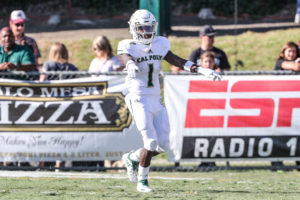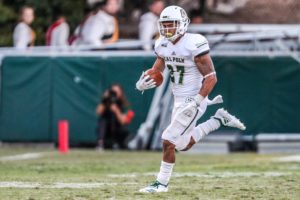Fansmanship Podcast Episode 217 – Chris Sylvester and Brint Wahlberg
It’s another podcast episode! Cal Poly basketball teams are at the Big...
On Saturday, Cal Poly hosted 17th-ranked Montana. The Mustangs came into the game 1-3 on the season, having won just two of their past 16 games overall.
So, not a great trend. This year hasn’t been easy though. The four games Cal Poly has lost (including to Montana) have all been against opponents ranked in the top-17 in the nation.
For me, one of the fascinating things about college sports — or any athletics at a really high level — is that there sometimes isn’t MUCH between a team that seems down in the dumps and a team that is in the top-20 in the nation. Saturday’s game, for me, was a fascinating case in point.
Cal Poly moved the ball like they wanted to and played basically as well as you can in a game you lose by 20 (the final score was 48-28).
There were 149 total plays in the game, and here are four that went a long way toward determining the outcome:
Cal Poly is a triple option team that goes for it on fourth down. A lot. If you depend on rushing the ball and can’t get a yard or two when you need it, then you’re probably not going to win anyway. Also, head coach Tim Walsh has long preached that touchdowns are what win games, not field goals.
After picking up one first down on their opening drive, Cal Poly had the ball at Montana’s 48 yard line on fourth down and 1. Cal Poly handed the ball to senior fullback Joe Protheroe, but the Grizzlies sniffed it out and stopped Cal Poly short.
Early fourth down plays can have lasting impacts on momentum in the trenches.
THE OUTCOME – Well, Cal Poly’s defense forced a Montana three-and-out, forcing a punt. Things looked OK until…..

J’uan Campbell rushed for 31 yards on four carries Saturday against Montana.
Photo by Owen Main
Since the Mustangs had gone for it on 4th down, Montana had good field position to pin Cal Poly back toward their own end zone. The Montana punter angled a high kick toward the corner. Cal Poly junior return man J’uan Campbell waved his teammates away as the ball bounced and rolled nearly out of bounds. Inexplicably, Campbell made a last second effort to pick up or dive on the ball.
Instead, Campbell simply touched it and Montana took possession at the Cal Poly 7 yard line.
THE OUTCOME – Two plays later, Dalton Sneed found Gabe Sulser for a six-yard touchdown and Montana led 10-0, less than seven minutes into the game.
Down 10-0 early-on, Cal Poly still had to believe they could get back into the game by sticking with their initial game plan. While the Montana defense HAD earned one stop, Cal Poly’s offense hadn’t even started to roll. Khaleel Jenkins and co. put together a drive that was vintage Cal Poly offense for the first 13 plays of the drive. Protheroe found some rhythm up the middle. Jenkins was making good option decisions. Campbell got back on track. Chuby Danu even caught a ball out of the backfield. Cal Poly used the first 13 plays of the drive to go 60 yards. At the Montana 16 yard line, it seemed like the Mustangs were ready to score a touchdown of their own and get back into the game.
Instead, the wheels fell off.
On an option play toward the Cal Poly sideline, Jenkins’ pitch to Danu careened off Danu and right into the waiting arms of Montana defender Josh Buss, who returned the fumble 80 yards for a Montana touchdown.
THE OUTCOME – Instead of the score being maybe 10-7, it was 17-0 Montana with 1:31 to go in a disastrous first quarter.
To their credit, the Mustangs didn’t hang their heads. Jenkins, Protheroe, and newly installed running back Drew Hernandez kept the Triple Option chugging. Cal Poly responded with a drive of over six minutes in the second quarter, culminating in a Protheroe touchdown, but Montana scored on their ensuing drive and once more before the half to go up 31-7 at halftime.
When you do the math on the 14 point swing of the pitch-6 and what might or might not have happened with the Muff, you might think about somewhere between 14 and 21 points being made-up. That means that instead of being boat-raced at 31-7 going into halftime, Cal Poly might have been within striking distance at something like 24-14. That’s a big difference.
Again, Cal Poly’s offense seemed to respond in the second half. They scored on each of their first two drives in the 3rd quarter, but so did Montana. Even trading a touchdown for a field goal, Cal Poly wasn’t making up ground. Down 41-21 early in the fourth quarter, the offense needed to keep scoring.
I hesitated putting this one in here. By the time you’re depending on conversion of a fourth and four, down by 20 points in the fourth quarter, maybe you’re grasping at straws. Still, Cal Poly had life. with 12:16 left in the game, on fourth and four from the Montana 22, Jenkins called his own number. He tried to cut upfield on an option play. He slipped and was smothered for no gain.
THE OUTCOME – Montana got the ball back on downs and scored on a 68 yard rush three plays later. It was a dagger for a Cal Poly team that rallied for a touchdown late to keep the score within 20.
****
Each of the above plays creates the circumstance needed for the next one to even take place, but when you put them all together, it makes up for most of the score difference between the two teams. I guess the good news if you’re a Mustang fan is that high leverage situations like fourth downs, special teams plays, and turnovers are things that can improve.

Drew Hernandez (27) was a pleasant surprise for Cal Poly fans, rushing for 135 yards on 14 carries Saturday against Montana.
Photo by Owen Main
Cal Poly out-gained Montana 512 yards to 468 yards and dominated time of possession (38:40 to 21:20). Cal Poly ran 95 plays to Montana’s 54. But two early turnovers weren’t something Cal Poly could overcome.
Cleaning up their play in those high-leverage areas could give the Mustangs a chance to win in the state capitol this weekend against Sacramento State.
You’ll also notice I didn’t mention the defense yet. Cal Poly’s defense wasn’t horrific, but it wasn’t great. They made some good third down stops (Montana was just 5/10 on third downs), but they also let some big plays happen, including Adam Eastwood’s 68 yard dagger. By the time the defense forced a turnover from the Grizzlies, an interception by Carter Nichols, the game was well in-hand.
The receivers throughout the Big Sky are really good and so are most of the passing quarterbacks. Sacks are hard to come by as quarterbacks are getting rid of the ball quickly. If the offense and special teams play a clean game, Cal Poly’s defense doesn’t have to do huge things with turnovers, sacks, and tackles for losses. If the Mustangs are behind by 20 points though, then the pressure on Josh Brown’s unit becomes higher. With a young defensive front, changing the game plan and becoming more urgent might lead to some of the late breakdown we saw with the long Eastwood touchdown run.
So, what’s next?
Look this weekend for high-leverage plays and whether they go Cal Poly’s way. Can the Mustangs convert on some fourth downs when they only have 1-3 yards to get? Can the offense keep from giving away possession and points and still run smoothly.
Smart football is good football in so many cases. With nearly 150 plays last game, there are lots of opportunities to slip-up, but if Cal Poly can play sound football this weekend, they’ll have a chance in the Hornets nest.
Photos by Owen Main. Click here for all photos
It’s another podcast episode! Cal Poly basketball teams are at the Big...
One of my favorite authors, Jeff Pearlman joins this edition of the...
Donovan Fields is one of the most joyous basketball players I’ve ever...
With the tournament more than underway and the sweet sixteen fast approaching,...
(Article by Luke “Loco” Johnson. Forgive website faux pas.) The genius of...
* Team Records accurate as of Friday morning, 8:39 A.M. The hyped hoopla...
